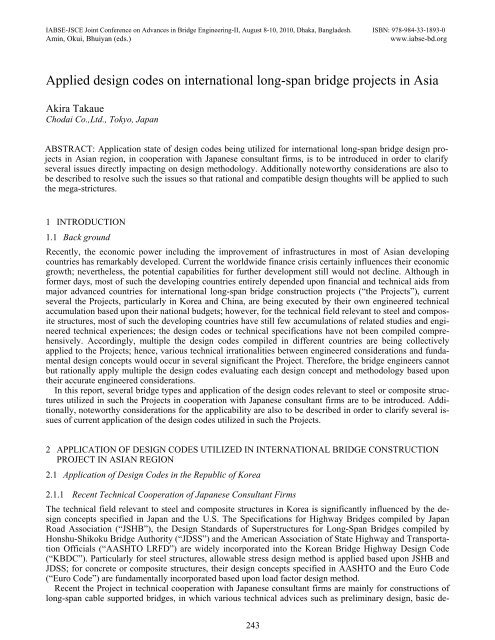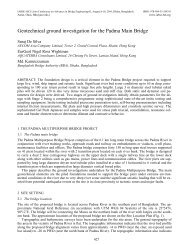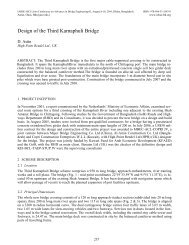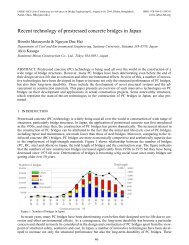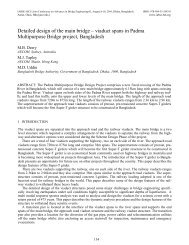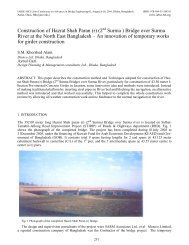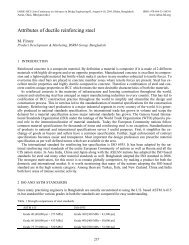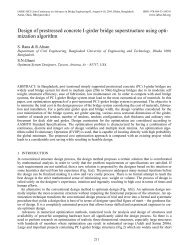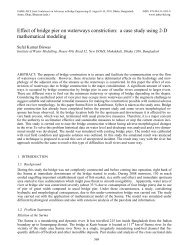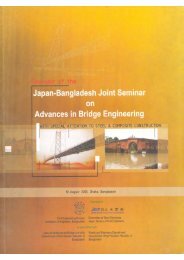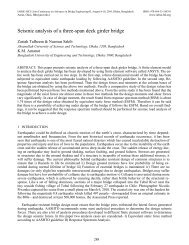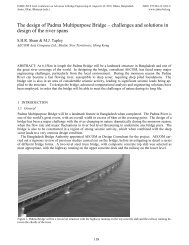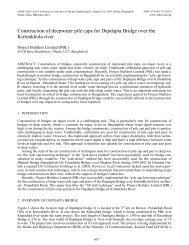Applied design codes on international long-span ... - Iabse-bd.org
Applied design codes on international long-span ... - Iabse-bd.org
Applied design codes on international long-span ... - Iabse-bd.org
You also want an ePaper? Increase the reach of your titles
YUMPU automatically turns print PDFs into web optimized ePapers that Google loves.
IABSE-JSCE Joint C<strong>on</strong>ference <strong>on</strong> Advances in Bridge Engineering-II, August 8-10, 2010, Dhaka, Bangladesh. ISBN: 978-984-33-1893-0<br />
Amin, Okui, Bhuiyan (eds.) www.iabse-<strong>bd</strong>.<strong>org</strong><br />
<str<strong>on</strong>g>Applied</str<strong>on</strong>g> <str<strong>on</strong>g>design</str<strong>on</strong>g> <str<strong>on</strong>g>codes</str<strong>on</strong>g> <strong>on</strong> internati<strong>on</strong>al l<strong>on</strong>g-<strong>span</strong> bridge projects in Asia<br />
Akira Takaue<br />
Chodai Co.,Ltd., Tokyo, Japan<br />
ABSTRACT: Applicati<strong>on</strong> state of <str<strong>on</strong>g>design</str<strong>on</strong>g> <str<strong>on</strong>g>codes</str<strong>on</strong>g> being utilized for internati<strong>on</strong>al l<strong>on</strong>g-<strong>span</strong> bridge <str<strong>on</strong>g>design</str<strong>on</strong>g> projects<br />
in Asian regi<strong>on</strong>, in cooperati<strong>on</strong> with Japanese c<strong>on</strong>sultant firms, is to be introduced in order to clarify<br />
several issues directly impacting <strong>on</strong> <str<strong>on</strong>g>design</str<strong>on</strong>g> methodology. Additi<strong>on</strong>ally noteworthy c<strong>on</strong>siderati<strong>on</strong>s are also to<br />
be described to resolve such the issues so that rati<strong>on</strong>al and compatible <str<strong>on</strong>g>design</str<strong>on</strong>g> thoughts will be applied to such<br />
the mega-strictures.<br />
1 INTRODUCTION<br />
1.1 Back ground<br />
Recently, the ec<strong>on</strong>omic power including the improvement of infrastructures in most of Asian developing<br />
countries has remarkably developed. Current the worldwide finance crisis certainly influences their ec<strong>on</strong>omic<br />
growth; nevertheless, the potential capabilities for further development still would not decline. Although in<br />
former days, most of such the developing countries entirely depended up<strong>on</strong> financial and technical aids from<br />
major advanced countries for internati<strong>on</strong>al l<strong>on</strong>g-<strong>span</strong> bridge c<strong>on</strong>structi<strong>on</strong> projects (“the Projects”), current<br />
several the Projects, particularly in Korea and China, are being executed by their own engineered technical<br />
accumulati<strong>on</strong> based up<strong>on</strong> their nati<strong>on</strong>al budgets; however, for the technical field relevant to steel and composite<br />
structures, most of such the developing countries have still few accumulati<strong>on</strong>s of related studies and engineered<br />
technical experiences; the <str<strong>on</strong>g>design</str<strong>on</strong>g> <str<strong>on</strong>g>codes</str<strong>on</strong>g> or technical specificati<strong>on</strong>s have not been compiled comprehensively.<br />
Accordingly, multiple the <str<strong>on</strong>g>design</str<strong>on</strong>g> <str<strong>on</strong>g>codes</str<strong>on</strong>g> compiled in different countries are being collectively<br />
applied to the Projects; hence, various technical irrati<strong>on</strong>alities between engineered c<strong>on</strong>siderati<strong>on</strong>s and fundamental<br />
<str<strong>on</strong>g>design</str<strong>on</strong>g> c<strong>on</strong>cepts would occur in several significant the Project. Therefore, the bridge engineers cannot<br />
but rati<strong>on</strong>ally apply multiple the <str<strong>on</strong>g>design</str<strong>on</strong>g> <str<strong>on</strong>g>codes</str<strong>on</strong>g> evaluating each <str<strong>on</strong>g>design</str<strong>on</strong>g> c<strong>on</strong>cept and methodology based up<strong>on</strong><br />
their accurate engineered c<strong>on</strong>siderati<strong>on</strong>s.<br />
In this report, several bridge types and applicati<strong>on</strong> of the <str<strong>on</strong>g>design</str<strong>on</strong>g> <str<strong>on</strong>g>codes</str<strong>on</strong>g> relevant to steel or composite structures<br />
utilized in such the Projects in cooperati<strong>on</strong> with Japanese c<strong>on</strong>sultant firms are to be introduced. Additi<strong>on</strong>ally,<br />
noteworthy c<strong>on</strong>siderati<strong>on</strong>s for the applicability are also to be described in order to clarify several issues<br />
of current applicati<strong>on</strong> of the <str<strong>on</strong>g>design</str<strong>on</strong>g> <str<strong>on</strong>g>codes</str<strong>on</strong>g> utilized in such the Projects.<br />
2 APPLICATION OF DESIGN CODES UTILIZED IN INTERNATIONAL BRIDGE CONSTRUCTION<br />
PROJECT IN ASIAN REGION<br />
2.1 Applicati<strong>on</strong> of Design Codes in the Republic of Korea<br />
2.1.1 Recent Technical Cooperati<strong>on</strong> of Japanese C<strong>on</strong>sultant Firms<br />
The technical field relevant to steel and composite structures in Korea is significantly influenced by the <str<strong>on</strong>g>design</str<strong>on</strong>g><br />
c<strong>on</strong>cepts specified in Japan and the U.S. The Specificati<strong>on</strong>s for Highway Bridges compiled by Japan<br />
Road Associati<strong>on</strong> (“JSHB”), the Design Standards of Superstructures for L<strong>on</strong>g-Span Bridges compiled by<br />
H<strong>on</strong>shu-Shikoku Bridge Authority (“JDSS”) and the American Associati<strong>on</strong> of State Highway and Transportati<strong>on</strong><br />
Officials (“AASHTO LRFD”) are widely incorporated into the Korean Bridge Highway Design Code<br />
(“KBDC”). Particularly for steel structures, allowable stress <str<strong>on</strong>g>design</str<strong>on</strong>g> method is applied based up<strong>on</strong> JSHB and<br />
JDSS; for c<strong>on</strong>crete or composite structures, their <str<strong>on</strong>g>design</str<strong>on</strong>g> c<strong>on</strong>cepts specified in AASHTO and the Euro Code<br />
(“Euro Code”) are fundamentally incorporated based up<strong>on</strong> load factor <str<strong>on</strong>g>design</str<strong>on</strong>g> method.<br />
Recent the Project in technical cooperati<strong>on</strong> with Japanese c<strong>on</strong>sultant firms are mainly for c<strong>on</strong>structi<strong>on</strong>s of<br />
l<strong>on</strong>g-<strong>span</strong> cable supported bridges, in which various technical advices such as preliminary <str<strong>on</strong>g>design</str<strong>on</strong>g>, basic de-<br />
243
sign, detail <str<strong>on</strong>g>design</str<strong>on</strong>g> and c<strong>on</strong>structi<strong>on</strong> supervisi<strong>on</strong> have been provided. Recent the c<strong>on</strong>tract method is not ec<strong>on</strong>omic<br />
aids provided by the government of Japan but the direct c<strong>on</strong>tract such as <str<strong>on</strong>g>design</str<strong>on</strong>g>-build c<strong>on</strong>tracting<br />
method between Japanese c<strong>on</strong>sultant firms and Korean relevant <strong>org</strong>anizati<strong>on</strong>s.<br />
2.1.2 Current Internati<strong>on</strong>al Project in Cooperati<strong>on</strong> with Japanese C<strong>on</strong>sultant Firms<br />
The largest current the Project in cooperati<strong>on</strong> with Japanese c<strong>on</strong>sultant firms is for the c<strong>on</strong>structi<strong>on</strong> of Sec<strong>on</strong>d<br />
Inche<strong>on</strong> Bridge shown in Figure 1. The bridge will be located <strong>on</strong> the sec<strong>on</strong>dary access highway c<strong>on</strong>necting<br />
Y<strong>on</strong>gj<strong>on</strong>g Island, <strong>on</strong> which the Inche<strong>on</strong> internati<strong>on</strong>al airport is located, to S<strong>on</strong>gdo New City. The centre <strong>span</strong><br />
length reaches 800m, which will be the third l<strong>on</strong>gest <strong>span</strong> of existing the cable-stayed bridges in the world.<br />
The bridge comp<strong>on</strong>ents were <str<strong>on</strong>g>design</str<strong>on</strong>g>ed applying AASHTO LRFD (3rd Editi<strong>on</strong> 2004) <strong>on</strong> the basis of limit <str<strong>on</strong>g>design</str<strong>on</strong>g><br />
state method. Each the steel and composite secti<strong>on</strong> was determined based up<strong>on</strong> several critical cases of<br />
load combinati<strong>on</strong>s resulted in comparing evaluati<strong>on</strong>s between KBDC and AASHTO LRFD; however, the<br />
Japanese <str<strong>on</strong>g>design</str<strong>on</strong>g> <str<strong>on</strong>g>codes</str<strong>on</strong>g> such as JSHB and JDSS were not applied. The reas<strong>on</strong>s why KBDC and the Japanese<br />
<str<strong>on</strong>g>design</str<strong>on</strong>g> <str<strong>on</strong>g>codes</str<strong>on</strong>g> were not entirely applied to the <str<strong>on</strong>g>design</str<strong>on</strong>g> were that rati<strong>on</strong>al <str<strong>on</strong>g>design</str<strong>on</strong>g> c<strong>on</strong>cepts were required based<br />
up<strong>on</strong> the limit state <str<strong>on</strong>g>design</str<strong>on</strong>g> method, and that technical intenti<strong>on</strong> of a British investing company that was a<br />
business owner of this PFI project.<br />
Figure 1: General Drawing of Sec<strong>on</strong>d Inche<strong>on</strong> Bridge.<br />
2.1.3 Secti<strong>on</strong> Forces Calculated in the Design Stage<br />
The secti<strong>on</strong> forces were calculated under various load combinati<strong>on</strong>s specified in AASHTO LRFD and KBDC,<br />
corresp<strong>on</strong>ding to several the limit states: i) Serviceability limit state, ii) Ultimate limit state iii) Accidental<br />
limit state. The temporary steel structures to be installed in erecti<strong>on</strong> stage were <str<strong>on</strong>g>design</str<strong>on</strong>g>ed based up<strong>on</strong> allowable<br />
stress <str<strong>on</strong>g>design</str<strong>on</strong>g> method.<br />
The secti<strong>on</strong> sizes of most of the bridge comp<strong>on</strong>ents such as cables, steel deck and girders were determined<br />
under specific load combinati<strong>on</strong>s including live loads. The comparis<strong>on</strong> of live loads specified in KBDC,<br />
AASHTO LRFD and JDSS is shown in the following Table 1., in which the strength of the live loads specified<br />
in KBDC is comparatively larger than those of AASHTO LRFD and JDSS. Generally, structural safety<br />
of an entire bridge based up<strong>on</strong> a comparis<strong>on</strong> of just <strong>on</strong>ly the load strength should not be estimated essentially<br />
because the m<strong>on</strong>olithic combinati<strong>on</strong> of load strength, load factors and <str<strong>on</strong>g>design</str<strong>on</strong>g> c<strong>on</strong>cepts would form an essential<br />
<str<strong>on</strong>g>design</str<strong>on</strong>g> system; otherwise, the strength of distributi<strong>on</strong> of the live loads, specified in KBDC and indicated<br />
in the table as DL, is obviously the largest of the other <str<strong>on</strong>g>design</str<strong>on</strong>g> <str<strong>on</strong>g>codes</str<strong>on</strong>g> in the table. Distributi<strong>on</strong> loads ordinary<br />
would become a dominant excitati<strong>on</strong>.<br />
Table 1: Comparis<strong>on</strong> of Live Loads Strength.<br />
DL indicates “Distributi<strong>on</strong> load”, and CL indicates “C<strong>on</strong>centrati<strong>on</strong> load”.<br />
KBDC AASHTO LRFD JDSS<br />
KOREA USA JAPAN<br />
DL=75.00 KN/m DL=48.36 KN/m DL=46.85 KN/m<br />
Live loads<br />
CL=918 KN<br />
CL=1690 KN<br />
(L=8.6-13.3m)<br />
CL=2154 KN<br />
Reducti<strong>on</strong> factor: Reducti<strong>on</strong> factor:<br />
The number of lanes:0.75 The number of lanes:0.55<br />
Wheel<br />
loads<br />
244<br />
Reducti<strong>on</strong> factor:<br />
The bridge length:0.87<br />
188 KN/axle 145 KN/axle 200 KN/axle<br />
2.1.4 C<strong>on</strong>siderati<strong>on</strong> <strong>on</strong> Design Methodology of L<strong>on</strong>g-Span Bridge Applying AASHTO LRFD<br />
This bridge would be an uncomm<strong>on</strong> example of l<strong>on</strong>g-<strong>span</strong> cable supported bridge applying AASHTO LRFD.<br />
Because large number of composite I-beam girder bridges has been c<strong>on</strong>structed in the U.S. as the standard<br />
steel bridge type, the specificati<strong>on</strong>s relevant to compressed stiffeners would be insufficient for <str<strong>on</strong>g>design</str<strong>on</strong>g>ing them
appropriately. AASHTO LRFD specifies the limited compressive strength and the required size of such the<br />
stiffeners based up<strong>on</strong> those of infinite length; hence, applying the methodology to the finite compressed stiffeners<br />
would not be rati<strong>on</strong>al. Therefore, the compressed flanges and webs were verified based up<strong>on</strong> FHWA-<br />
80-205, in which ultimate strength are schematised <strong>on</strong> the basis of experimental or analysed results approached<br />
from various specimens of columns.<br />
For horiz<strong>on</strong>tal stiffeners <strong>on</strong> girders, the minimum thickness of base plates requisite for installing the horiz<strong>on</strong>tal<br />
stiffeners is specified to be determined by the ratio of the thickness and the height of the base plates:<br />
D/tw150. Moreover, double<br />
layer installati<strong>on</strong> of the horiz<strong>on</strong>tal stiffeners is not specifically allowed.<br />
As menti<strong>on</strong>ed above, various methodological irrati<strong>on</strong>alities between bridge engineer’s demands and <str<strong>on</strong>g>design</str<strong>on</strong>g><br />
methodology would occur in the detail <str<strong>on</strong>g>design</str<strong>on</strong>g> stage because of differences of <str<strong>on</strong>g>design</str<strong>on</strong>g> c<strong>on</strong>cepts. Therefore, the<br />
bridge engineers must <str<strong>on</strong>g>design</str<strong>on</strong>g> rati<strong>on</strong>ally apply multiple the <str<strong>on</strong>g>design</str<strong>on</strong>g> <str<strong>on</strong>g>codes</str<strong>on</strong>g> evaluating each the <str<strong>on</strong>g>design</str<strong>on</strong>g> c<strong>on</strong>cept<br />
and methodology based up<strong>on</strong> their accurate engineered c<strong>on</strong>siderati<strong>on</strong>s and demands.<br />
2.2 Applicati<strong>on</strong> of Design Codes in the People’s Republic of China<br />
2.2.1 Recent Technical Cooperati<strong>on</strong> of Japanese C<strong>on</strong>sultant Firms<br />
Recent the Projects in technical cooperati<strong>on</strong> with Japanese c<strong>on</strong>sultant firms are mainly for l<strong>on</strong>g-<strong>span</strong> suspensi<strong>on</strong><br />
bridge projects. Current Chinese bridge engineers have efficient experiences of <str<strong>on</strong>g>design</str<strong>on</strong>g>ing and c<strong>on</strong>structing<br />
large number of domestic steel bridges including several l<strong>on</strong>g-<strong>span</strong> suspensi<strong>on</strong> bridges erected across<br />
Changjiang River; accordingly, they have efficient c<strong>on</strong>fidence with engineered capabilities based up<strong>on</strong> such<br />
accumulati<strong>on</strong> of the experiences. The Projects including planning, computer analysis, <str<strong>on</strong>g>design</str<strong>on</strong>g>ing, fabricati<strong>on</strong>,<br />
manufacturing and c<strong>on</strong>structi<strong>on</strong> would be comprehensively accomplished appropriately by their ownengineered<br />
capabilities. In particular, the <str<strong>on</strong>g>design</str<strong>on</strong>g>ing based up<strong>on</strong> numerical computerized analysis resulted<br />
from rather highly-analysis methodology, using commercialised general software, is being performed in c<strong>on</strong>siderati<strong>on</strong><br />
of various <str<strong>on</strong>g>design</str<strong>on</strong>g> methodology incorporated from foreign <str<strong>on</strong>g>design</str<strong>on</strong>g> <str<strong>on</strong>g>codes</str<strong>on</strong>g>.<br />
The opportunities for forwarding orders of the <str<strong>on</strong>g>design</str<strong>on</strong>g> to foreign c<strong>on</strong>sultant firms are currently being decreased;<br />
meanwhile, the independent check <strong>on</strong> the results performed by Chinese <str<strong>on</strong>g>design</str<strong>on</strong>g> firms are current major<br />
technical cooperati<strong>on</strong> by the foreign c<strong>on</strong>sultant firms, such as verificati<strong>on</strong> of detailed <str<strong>on</strong>g>design</str<strong>on</strong>g>, technical advices<br />
for fabricati<strong>on</strong> and c<strong>on</strong>structi<strong>on</strong> supervisi<strong>on</strong> for inexperienced types of l<strong>on</strong>g-<strong>span</strong> bridges.<br />
2.2.2 Current Internati<strong>on</strong>al Project in Cooperati<strong>on</strong> with Japanese C<strong>on</strong>sultant Firms<br />
One of the latest the Project being executed in China in cooperati<strong>on</strong> with Japanese c<strong>on</strong>sultant firm is to be introduced<br />
in this subsecti<strong>on</strong>.<br />
This l<strong>on</strong>g <strong>span</strong> steel truss suspensi<strong>on</strong> bridge, shown in Figure 2, is c<strong>on</strong>structed <strong>on</strong> the mountainous area in<br />
Guizhou province in south of China, the <strong>span</strong> length of which is 1088m; it will be the seventeenth l<strong>on</strong>gest<br />
<strong>span</strong> of existing the suspensi<strong>on</strong> bridges in the world toward the completi<strong>on</strong> in 2011. The <str<strong>on</strong>g>design</str<strong>on</strong>g> stage including<br />
detail <str<strong>on</strong>g>design</str<strong>on</strong>g>, c<strong>on</strong>structi<strong>on</strong> drawing and demoliti<strong>on</strong> analysis has been performed by CCCC Highway C<strong>on</strong>sultants<br />
in China under supervisi<strong>on</strong> of the ministry of communicati<strong>on</strong>. A Japanese c<strong>on</strong>sultant firm has implemented<br />
the independent check to provided technical advices <strong>on</strong> the <str<strong>on</strong>g>design</str<strong>on</strong>g> stages.<br />
Figure 2: General Drawing of Guizhou Balinghe Bridge, Prepared by CCCC Highway C<strong>on</strong>sultants Co.,LTD.<br />
245
2.2.3 Independent Check <strong>on</strong> the Design Stage<br />
The independent check, the verified items of which are enumerated as follows, utilizing the Japanese <str<strong>on</strong>g>design</str<strong>on</strong>g><br />
<str<strong>on</strong>g>codes</str<strong>on</strong>g>, was performed in order to c<strong>on</strong>firm appropriate validity and structural safety for the <str<strong>on</strong>g>design</str<strong>on</strong>g> stage performed<br />
by Chinese c<strong>on</strong>sultant firms. In this subsecti<strong>on</strong>, several verificati<strong>on</strong> results such as the trussed chords<br />
and the suspender cables as a part of the cable system are to be introduced.<br />
i) C<strong>on</strong>firmati<strong>on</strong> of deformati<strong>on</strong> and safety under static loads such as dead, live, wind loads and thermal effects.<br />
ii) Safety check during c<strong>on</strong>structi<strong>on</strong> stage.<br />
iii) Aerodynamic stability based up<strong>on</strong> eigenvalue analysis<br />
Various <str<strong>on</strong>g>design</str<strong>on</strong>g> <str<strong>on</strong>g>codes</str<strong>on</strong>g> utilized by both the stages such as the <str<strong>on</strong>g>design</str<strong>on</strong>g> stage and the independent check stage<br />
are enumerated as follows. In the independent check stage, <str<strong>on</strong>g>design</str<strong>on</strong>g> loads were applied based up<strong>on</strong> the Chinese<br />
<str<strong>on</strong>g>design</str<strong>on</strong>g> code and the results of the <str<strong>on</strong>g>design</str<strong>on</strong>g> stage.<br />
2.2.4 Applicati<strong>on</strong> of Design Codes Utilized for the Detail Design.<br />
i) Technical Standard of Highway Engineering (JTG B01-2003, China)<br />
ii) Wind-Resistant Design Specificati<strong>on</strong> for Highway Bridge (JTG/TD60-01 2004, China)<br />
iii) General Code of Design of Highway Bridge and Calvert (JTG D60-2004, China)<br />
iv) Structural Steel for Bridge (GB/T 714-2000, China)<br />
v) Carb<strong>on</strong> Structural Steels (GB700-88, China)<br />
vi) Quality Inspecti<strong>on</strong> and Evaluati<strong>on</strong> Standards for Highway Engineering (JTJ071-98, China)<br />
2.2.5 Applicati<strong>on</strong> of Design Codes Utilized for the Independent Check<br />
i) Specificati<strong>on</strong>s for Highway Bridges Part I, II (Japan Road Associati<strong>on</strong>, 2002)<br />
ii) Design Standards of Superstructures for L<strong>on</strong>g-Span Bridges (H<strong>on</strong>shu-Shikoku Bridge Authority)<br />
iii) Wind-Resistant Design Specificati<strong>on</strong> for H<strong>on</strong>shu-Shikoku bridge (H<strong>on</strong>shu-Shikoku Bridge Expressway<br />
Co.,LTD, 2001)<br />
iv) Technical Standard of Highway Engineering (JTG B01-2003, China)<br />
v) Wind-Resistant Design Specificati<strong>on</strong> for Highway Bridge (JTG/TD60-01 2004, China)<br />
vi) Standards of Fatigue Design for Steel Highway Bridge (Japan Road Associati<strong>on</strong>, 2002)<br />
vii) The Japanese Industrial Standards (“JIS”) utilized for steel and relevant materials<br />
2.2.6 Design Loads<br />
Design loads applied to the independent check were basically utilized based up<strong>on</strong> the drawings prepared by<br />
Chinese c<strong>on</strong>sultant firms. The live loads, <str<strong>on</strong>g>design</str<strong>on</strong>g> wind velocity and gust factors were applied based up<strong>on</strong> the<br />
Chinese <str<strong>on</strong>g>design</str<strong>on</strong>g> <str<strong>on</strong>g>codes</str<strong>on</strong>g> menti<strong>on</strong>ed above. The load combinati<strong>on</strong>s were determined based up<strong>on</strong> JDSS, enumerated<br />
as follows.<br />
i) Dead loads + Live loads + Thermal effects: D+L+T<br />
ii) Dead loads + Thermal effects + Wind loads: D+T+W<br />
The required additi<strong>on</strong>al factor of 1.5 was c<strong>on</strong>sidered under the wind loads combinati<strong>on</strong>.<br />
2.2.7 Safety Evaluati<strong>on</strong> of Upper And Lower Chords<br />
The following figures show distributi<strong>on</strong> of axial forces occurring in the upper and lower chords. The green<br />
lines indicates the axial forces caused under the live loads such as D+L+T; the blue lines indicates the axial<br />
forces c<strong>on</strong>sidering the required additi<strong>on</strong>al factor under the wind loads such as D+T+L/1.5; the red lines indicates<br />
allowable axial forces calculated based up<strong>on</strong> JSHB. For the steel specificati<strong>on</strong>s, the steel SM490 specified<br />
in JIS was applied to the independent check stage because the SM490 is matallurgically equivalent to the<br />
steel Q345 that is a Chinese steel specificati<strong>on</strong> applied to the <str<strong>on</strong>g>design</str<strong>on</strong>g> stage.<br />
As shown in the figures, the axial forces occurring in the chords meet the allowable axial forces within<br />
valid differences although the results are obtained under the live loads specified in the Chinese <str<strong>on</strong>g>design</str<strong>on</strong>g> code.<br />
2.2.8 Safety Evaluati<strong>on</strong> of Suspenders<br />
The rapture tensile force and the material specificati<strong>on</strong> of the suspenders were determined in the <str<strong>on</strong>g>design</str<strong>on</strong>g> such<br />
as Tb=6600 KN/suspender (8x41SW+IWR D=52mm-4 strand wire ropes). The maximum tensile force of a<br />
suspender occurred in a case under the load combinati<strong>on</strong> including live loads. Figure 4 and Table 2 show the<br />
246
locati<strong>on</strong> of the extracted suspenders and the tensile forces. The tensile forces occurring in the extracted suspenders<br />
meet the allowable values c<strong>on</strong>sidering the safety factor of 4.0. In comparis<strong>on</strong> with the load combinati<strong>on</strong><br />
utilizing the Japanese live loads specified in JSHB, generated tensile forces meet the results using Chinese<br />
live loads within four present.<br />
UPPER CHORD AXIAL FORCE<br />
kN<br />
-12000<br />
-10500<br />
-9000<br />
-7500<br />
-6000<br />
-4500<br />
-3000<br />
-1500<br />
0<br />
1500<br />
3000<br />
4500<br />
6000<br />
7500<br />
9000<br />
10500<br />
12000<br />
13500<br />
15000<br />
16500<br />
18000<br />
19500<br />
21000<br />
22500<br />
MAX<br />
MIN<br />
5092.93 KN<br />
-6967.08 KN<br />
D+L+T<br />
(D+T+W)/1.5<br />
RESISTING AXIAL FORCE<br />
Figure 3: Distributi<strong>on</strong> of Axial Forces in Upper and Lower chords<br />
Figure 4: Locati<strong>on</strong> of Extracted Suspenders<br />
LOWER CHORD AXIAL FORCE<br />
kN<br />
Table 2: Tensile Forces in the Extracted Suspenders<br />
Unit<br />
Suspender No.<br />
1313 1327 1339 1351<br />
Tensile Force KN 1591 1602 1623 1632<br />
Rapture Strength KN 6600 6600 6600 6600<br />
Allowable factor 4.1>4.0 OK 4.1>4.0 OK 4.1>4.0 OK 4.0>4.0 OK<br />
The <str<strong>on</strong>g>design</str<strong>on</strong>g> c<strong>on</strong>cepts specified in the Japanese <str<strong>on</strong>g>design</str<strong>on</strong>g> <str<strong>on</strong>g>codes</str<strong>on</strong>g> are widely incorporated into the Chinese <str<strong>on</strong>g>design</str<strong>on</strong>g><br />
<str<strong>on</strong>g>codes</str<strong>on</strong>g> although the traffic loads are slightly different from those specified in JSHB.<br />
We will c<strong>on</strong>tinuously observe the technical development relevant to the <str<strong>on</strong>g>design</str<strong>on</strong>g> <str<strong>on</strong>g>codes</str<strong>on</strong>g> compiled in China<br />
comprehensively in the future, and will investigate further developed c<strong>on</strong>siderati<strong>on</strong>s relevant to the differences<br />
between the Chinese <str<strong>on</strong>g>design</str<strong>on</strong>g> <str<strong>on</strong>g>codes</str<strong>on</strong>g> and foreign <strong>on</strong>es from engineered aspects.<br />
2.3 Applicati<strong>on</strong> of Design Codes in the Socialist Republic of Vietnam<br />
-12000<br />
-10500<br />
-9000<br />
-7500<br />
-6000<br />
-4500<br />
-3000<br />
-1500<br />
0<br />
1500<br />
3000<br />
4500<br />
6000<br />
7500<br />
9000<br />
10500<br />
12000<br />
13500<br />
15000<br />
16500<br />
18000<br />
19500<br />
21000<br />
22500<br />
MAX<br />
MIN<br />
6859.19 KN<br />
-5186.15 KN<br />
2.3.1 Recent Technical Cooperati<strong>on</strong> of Japanese C<strong>on</strong>sultant Firms<br />
Vietnam is remarkably being developed under various financial and technical investments aided from advanced<br />
countries; however, the improvement of the technical field relevant to steel and composite structures<br />
is still stagnant behind menti<strong>on</strong>ed foregoing the countries. The <str<strong>on</strong>g>design</str<strong>on</strong>g> c<strong>on</strong>cepts of the Vietnamese <str<strong>on</strong>g>design</str<strong>on</strong>g><br />
<str<strong>on</strong>g>codes</str<strong>on</strong>g> basically are based up<strong>on</strong> limit state <str<strong>on</strong>g>design</str<strong>on</strong>g> method utilizing load factor <str<strong>on</strong>g>design</str<strong>on</strong>g> method, most of the<br />
chapters of which depends up<strong>on</strong> AASHTO LRFD, and are written in both English and Vietnamese. The <strong>on</strong>ly<br />
<str<strong>on</strong>g>design</str<strong>on</strong>g> loads are specified originally in the Vietnamese <str<strong>on</strong>g>design</str<strong>on</strong>g> <str<strong>on</strong>g>codes</str<strong>on</strong>g>. Recent the Projects in technical cooperati<strong>on</strong><br />
with Japanese c<strong>on</strong>sultant firms are being executed based up<strong>on</strong> the special Japanese yen loan granted in<br />
the Official Development Assistance (“ODA”).<br />
247<br />
D+L+T<br />
(D+T+W)/1.5<br />
RESISTING AXIAL FORCE<br />
248 m 1088 m 228 m<br />
MEMBER 1313<br />
MEMBER 1327<br />
MEMBER 1351<br />
MEMBER 1339
2.3.2 Binh Bridge<br />
Binh Bridge shown in Figure 5 is located in Haiph<strong>on</strong> city in Vietnam. This project was the first project financed<br />
by the special yen loan granted in December 1998. The bridge c<strong>on</strong>sists of 17-<strong>span</strong> c<strong>on</strong>tinuous steel<br />
and pre-cast RC slab composite girders, the three centre <strong>span</strong>s of which are cable-stayed types. In the <str<strong>on</strong>g>design</str<strong>on</strong>g><br />
stage, the specificati<strong>on</strong>s of the bridge were determined by applying the Finnish <str<strong>on</strong>g>design</str<strong>on</strong>g> <str<strong>on</strong>g>codes</str<strong>on</strong>g> in accordance<br />
with Vietnamese road specificati<strong>on</strong>s; however, the Japanese special yen loan was realized after the <str<strong>on</strong>g>design</str<strong>on</strong>g><br />
stage; several material and structural specificati<strong>on</strong>s have been modified based up<strong>on</strong> the Japanese <str<strong>on</strong>g>design</str<strong>on</strong>g><br />
<str<strong>on</strong>g>codes</str<strong>on</strong>g>.<br />
Figure 5: Binh Bridge: Steel Cable-Stayed Bridge (260m)<br />
2.3.3 Can Tho Bridge<br />
Can Tho Bridge shown in Figure 6 is being c<strong>on</strong>structed in Can Tho city. The main <strong>span</strong> will be 550m, which<br />
will be the l<strong>on</strong>gest cable-stayed bridge in Vietnam after the bridge completi<strong>on</strong>. The deck and girder were <str<strong>on</strong>g>design</str<strong>on</strong>g>ed<br />
as a hybrid structure. For the main <strong>span</strong> of 550m, the centre area, the length of which is 210m, will be<br />
composed from steel deck box girders; the other area will be c<strong>on</strong>structed by PC box girders, the shape of<br />
which was <str<strong>on</strong>g>design</str<strong>on</strong>g>ed as similar shape to steel deck of the centre area. The reas<strong>on</strong>s are described as follows.<br />
i) Generally, both of bending moments and axial compressive forces occur in the deck of a cable-stayed<br />
bridge. The deck is under full compressive c<strong>on</strong>diti<strong>on</strong> except the centre area where bending moments are predominant<br />
over other secti<strong>on</strong>al forces. Therefore, the steel structures, which will attain remarkable reducti<strong>on</strong> of<br />
dead loads in comparis<strong>on</strong> with PC structures, were applied to the centre area where tensile stress was predominant<br />
due to the bending moments.<br />
ii) If PC box girders were applied to the centre area c<strong>on</strong>tinuously, injurious stati<strong>on</strong>ary uplifting forces would<br />
be caused in the side <strong>span</strong>s; thus, the steel structures were applied to the centre area in order to reduce the stati<strong>on</strong>ary<br />
uplifting force without any counterweights.<br />
Although such the projects executed by Japanese financial aid have been generally performed by applying<br />
the Japanese <str<strong>on</strong>g>design</str<strong>on</strong>g> <str<strong>on</strong>g>codes</str<strong>on</strong>g>, this bridge project is basically based up<strong>on</strong> AASHTO LRFD and partially the<br />
original excitati<strong>on</strong>s specified in the Vietnamese <str<strong>on</strong>g>design</str<strong>on</strong>g> <str<strong>on</strong>g>codes</str<strong>on</strong>g>. C<strong>on</strong>sequently, the specificati<strong>on</strong>s of steel and<br />
other materials specified in JIS were partially and carefully applied to the bridge in order to maintain the <str<strong>on</strong>g>design</str<strong>on</strong>g><br />
c<strong>on</strong>cepts specified in AASHTO LRFD because the m<strong>on</strong>olithic combinati<strong>on</strong> of load strength, load factors<br />
and <str<strong>on</strong>g>design</str<strong>on</strong>g> methodologies would form an essential <str<strong>on</strong>g>design</str<strong>on</strong>g> system.<br />
Figure 6: Can Tho Bridge (Rendering Drawing)<br />
248
2.4 Applicati<strong>on</strong> of Design Codes in Oceania<br />
Recent the Projects in Oceania in technical cooperati<strong>on</strong> with Japanese c<strong>on</strong>sultant firms have been executed<br />
based up<strong>on</strong> the special Japanese yen loan granted in ODA. Because the aided countries are almost island<br />
countries <strong>on</strong> the Pacific Ocean, steel or composite bridges, which would be weak against corrosi<strong>on</strong>s, have<br />
been avoided to be c<strong>on</strong>structed by Japanese c<strong>on</strong>sulting firms and relevant <strong>org</strong>anizati<strong>on</strong>s.<br />
Therefore, an example of the Independent State of Papua New Guinea (“PNG”) where a lot of steel bridges<br />
aided by Australia and Japan is to be introduced in this subsecti<strong>on</strong>. The example is the urgent rehabilitati<strong>on</strong><br />
project of Markham Bridge shown in Figure 7. The bridge is the l<strong>on</strong>gest steel girder <strong>on</strong>e in PNG, the superstructure<br />
of which c<strong>on</strong>sists of 3x5-<strong>span</strong> c<strong>on</strong>tinuous steel girders erected by the financial aid of Australia in<br />
1973. The major purposes of the project relevant to steel and composite structures were evaluati<strong>on</strong> of proof<br />
strength of the superstructure under increased traffic loads.<br />
Figure 7: Current Markham Bridge<br />
The PNG’s <str<strong>on</strong>g>design</str<strong>on</strong>g> <str<strong>on</strong>g>codes</str<strong>on</strong>g> relevant to steel and composite structures are not compiled by themselves; they<br />
have just <strong>on</strong>ly the seismic <str<strong>on</strong>g>design</str<strong>on</strong>g> standards and the flood estimati<strong>on</strong> manual, both of which were compiled in<br />
technical cooperati<strong>on</strong> with New Zealander and Australian firms respectively. The major <str<strong>on</strong>g>design</str<strong>on</strong>g> <str<strong>on</strong>g>codes</str<strong>on</strong>g>, utilised<br />
for this rehabilitati<strong>on</strong> project, are enumerated as follows.<br />
i) Specificati<strong>on</strong>s for Highway Bridges Part I, II (Japan Road Associati<strong>on</strong>, 2002)<br />
ii) Australian Standard “Bridge <str<strong>on</strong>g>design</str<strong>on</strong>g> Part2: Design loads・AS 5100.1-2004<br />
iii) Standards of Fatigue Design for Steel Highway Bridge (Japan Road Associati<strong>on</strong>, 2002)<br />
iv) JIS (Japanese Industrial Standards) utilized for steel and relevant materials.<br />
3 CONCLUSION<br />
In this report, several bridge types and applicati<strong>on</strong> of the <str<strong>on</strong>g>design</str<strong>on</strong>g> <str<strong>on</strong>g>codes</str<strong>on</strong>g> relevant to steel or composite structures<br />
utilized in internati<strong>on</strong>al l<strong>on</strong>g-<strong>span</strong> bridge c<strong>on</strong>structi<strong>on</strong> projects executed in Asian regi<strong>on</strong> in cooperati<strong>on</strong><br />
with Japanese c<strong>on</strong>sultant firms are introduced. Additi<strong>on</strong>ally, noteworthy c<strong>on</strong>siderati<strong>on</strong>s for the applicability<br />
are also described.<br />
In immediate future, the <str<strong>on</strong>g>design</str<strong>on</strong>g> c<strong>on</strong>cepts of steel or composite structures specified in the Japanese <str<strong>on</strong>g>design</str<strong>on</strong>g><br />
<str<strong>on</strong>g>codes</str<strong>on</strong>g> will be revised in order to apply load factor <str<strong>on</strong>g>design</str<strong>on</strong>g> method; c<strong>on</strong>sequently, the actual results of the Project<br />
applying new revised the Japanese <str<strong>on</strong>g>design</str<strong>on</strong>g> <str<strong>on</strong>g>codes</str<strong>on</strong>g> will be increased although AASHTO LRFD or Euro<br />
Code based up<strong>on</strong> such the <str<strong>on</strong>g>design</str<strong>on</strong>g> methodology have been applied until now to several the Projects even executed<br />
by Japanese financial aids.<br />
However, most of the developing countries have still few accumulati<strong>on</strong>s of related studies and engineered<br />
technical experiences; the <str<strong>on</strong>g>design</str<strong>on</strong>g> <str<strong>on</strong>g>codes</str<strong>on</strong>g> or technical specificati<strong>on</strong>s have not been improved or compiled comprehensively.<br />
Accordingly, multiple the <str<strong>on</strong>g>design</str<strong>on</strong>g> <str<strong>on</strong>g>codes</str<strong>on</strong>g> compiled in different countries are being collectively<br />
applied to the Projects; hence, various technical irrati<strong>on</strong>alities between engineered c<strong>on</strong>siderati<strong>on</strong>s and fundamental<br />
<str<strong>on</strong>g>design</str<strong>on</strong>g> c<strong>on</strong>cepts would occur in several significant the Project. Therefore, the bridge engineers cannot<br />
but rati<strong>on</strong>ally apply multiple the <str<strong>on</strong>g>design</str<strong>on</strong>g> <str<strong>on</strong>g>codes</str<strong>on</strong>g> evaluating each the <str<strong>on</strong>g>design</str<strong>on</strong>g> c<strong>on</strong>cept and methodology based<br />
up<strong>on</strong> their accurate engineered c<strong>on</strong>siderati<strong>on</strong>s.<br />
C<strong>on</strong>sequently, the development of the unified <str<strong>on</strong>g>design</str<strong>on</strong>g> code such as the Asia Code, which should be compiled<br />
to be incorporated with various studies and engineered technical experiences accumulated in various the<br />
major <str<strong>on</strong>g>design</str<strong>on</strong>g> <str<strong>on</strong>g>codes</str<strong>on</strong>g>, is extremely informative for the bridge engineers being involved with such the Projects.<br />
249
REFERENCES<br />
Hayashi, K., (2006). Design and C<strong>on</strong>structi<strong>on</strong> of Bai Chay Bridge in Vietnam (Written in Japanese). Civil Engineering C<strong>on</strong>sultant,<br />
233, 52-55<br />
Matsuno et al (2006). C<strong>on</strong>structi<strong>on</strong> Report for “Binh Bridge” in Vietnam (Written in Japanese). Ishikawajima-Harima engineering<br />
review, 46(1), 6-23.<br />
Ohga, M., Takaue, A. (2001). Effects of initial imperfecti<strong>on</strong>s <strong>on</strong> n<strong>on</strong>linear behaviors of thin-walled members. Internati<strong>on</strong>al Journal<br />
of Structural Engineering and Mechanics, 11(5), 519-534<br />
Shin et al. (2008). Cable Stayed Bridge Design of Inche<strong>on</strong> Bridge in Republic of korea (Written in Japanese). Bridge and Foundati<strong>on</strong><br />
Engineering, 2008.2, 20-26.<br />
Tamura, A., Miura, K. and NAKAMURA, H. (2005). Positi<strong>on</strong> and Role of C<strong>on</strong>sultant in Design Built (Written in Japanese).<br />
Bridge and City, 2005.1, 24-29.<br />
250


